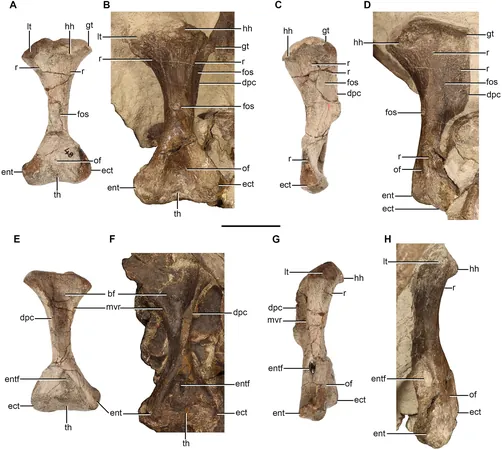
Unearthing the Secrets of Moschorhinus kitchingi: The Resilient Predator of Prehistoric Earth
2024-10-03
Imagine a time when the Earth was wracked by catastrophic volcanic eruptions, oceans teetered on the brink of acidity, and up to 90% of the planet's species faced sudden extinction. This was the perilous reality at the end of the Permian Period, approximately 252 million years ago, marking the planet's most devastating mass extinction event.
Amid this global chaos, a stout predator known as Moschorhinus kitchingi emerged as one of the top predators during this tumultuous period. Measuring just over a meter in length, Moschorhinus defied the odds, evolving into a key survivor when countless other species vanished.
For the first time, a group of researchers from the University of the Witwatersrand and the University of Southern California has provided a thorough analysis of the Moschorhinus skeleton, moving beyond its skull to explore multiple fossil specimens from South African collections. This groundbreaking study, spearheaded by Wits Ph.D. student Brandon Stuart, alongside colleagues Adam Huttenlocker and Jennifer Botha, was published in the journal PeerJ.
The findings detail how Moschorhinus kitchingi adapted its physical structure to survive in the extreme conditions that spelled doom for many of its contemporaries. Unlike the more well-known dinosaurs that would come millions of years later, Moschorhinus belonged to a lesser-known group of prehistoric creatures called therocephalians, which are closely related to early mammal ancestors.
The Permo-Triassic extinction is often compared to today's climate crisis due to rapid shifts in temperature and atmospheric conditions. By studying resilient species like Moschorhinus, scientists can glean insights into the adaptations that allowed certain organisms to thrive amid mass extinctions—knowledge that could prove invaluable for understanding how current species may cope with rapid environmental changes.
Moschorhinus's robust build set it apart from other dominant predators of its time, such as the more elegant gorgonopsians. While both creatures occupied similar ecological niches, subtle anatomical differences hint that Moschorhinus utilized diverse prey and hunting strategies, a phenomenon known as niche partitioning. This could have been a pivotal factor in its survival during a period rife with competition and upheaval.
Brandon Stuart states, "Therocephalians represent a fascinating chapter in the story of early vertebrates, closely linked to the evolution of mammals." Most earlier studies focused solely on their cranial structures, leaving significant gaps in our understanding of their growth, anatomy, and behavior. Now, detailed examinations of Moschorhinus's skeletal system shed light on these remarkable survivors.
Found in the geologically rich Karoo Basin of South Africa, Moschorhinus fossils reveal a robust skeletal framework conducive to strength and predation. The thick-set bones, including a powerful humerus and femur, suggest this ancient predator was well-equipped for tackling its prey. With a muscular build and notably enlarged canines, Moschorhinus was a formidable hunter capable of subduing larger animals.
Despite the challenges faced during this research—most studies have primarily examined skulls rather than other skeletal parts—this work lays the groundwork for future exploration of the anatomy of ancestral mammals. "By analyzing bones beyond the skull, we are unraveling the true form and function of these prehistoric creatures,” adds Stuart.
The study not only enriches our understanding of Moschorhinus but also illuminates the evolutionary resilience of therocephalians, a group often overshadowed by the more celebrated dinosaurs. This detailed investigation into Moschorhinus’s skeleton fills crucial gaps in the fossil record and underscores the significance of these lesser-known creatures in comprehending the tapestry of prehistoric life.
As researchers continue to delve into the uncharted territories of non-mammalian therapsid evolution, each new discovery holds the promise of unveiling hidden secrets about their biology, behavior, and the ecosystems they once dominated. The story of Moschorhinus serves as a gripping reminder of nature's resilience, and it compels us to reflect on the survival of species in a world of incessant change.





 Brasil (PT)
Brasil (PT)
 Canada (EN)
Canada (EN)
 Chile (ES)
Chile (ES)
 España (ES)
España (ES)
 France (FR)
France (FR)
 Hong Kong (EN)
Hong Kong (EN)
 Italia (IT)
Italia (IT)
 日本 (JA)
日本 (JA)
 Magyarország (HU)
Magyarország (HU)
 Norge (NO)
Norge (NO)
 Polska (PL)
Polska (PL)
 Schweiz (DE)
Schweiz (DE)
 Singapore (EN)
Singapore (EN)
 Sverige (SV)
Sverige (SV)
 Suomi (FI)
Suomi (FI)
 Türkiye (TR)
Türkiye (TR)